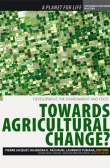Redefining Forestry for Effective Livelihoods
Book Details
Forests play a very important part in the rural economy. The rural population largely depends on forests for their livelihoods. Degradation and deforestation of forests have a negative impact on the rural people. They increase suffering and poverty. At the same time, they pose a serious, global environmental threat. It is necessary that the livelihood option of rural population is secured while forest resources augmented. This can be done through participatory management.
Redefining Forestry for Effective Livelihoods brings out key issues relevant to forest and livelihood, with a special focus on non-timber forest produce. It gives a detailed analysis about how forests play an important role in maintaining earth’s ecosystem and, thus, the vital balance of flora and fauna. The book also discusses the contribution of forests to the national economy. It also focuses on emerging research issues arising out of various policies and their impact on the forest-dependent poor. The book provides the essential findings, arguments, linkage of forestry sector with other development scenario and the possible way out for the future. This comprehensive book is a useful reference for researchers, policymakers, and development practitioners working in the area of forest and livelihood.
Target Audience
-
Graduate and Postgraduate students, Researchers, Academicians, and Professionals in the fields of Environmental Sciences, Forestry
Table of Contents
1. Forest Resources and their Ecosystem
1.1 Forest Resources
1.2 Forest Ecosystem Characteristics
1.3 India’s Forest Resources
1.4 Forest Cover in Tribal Districts of India as a Source of Sustenance and Livelihood
1.5 Plantation Efforts in National Forests
1.6 Forest Ecosystem Services
1.7 Conclusion
2. Forest, Poverty, and Tribal Livelihoods
2.1 Forest, People, and Livelihood
2.2 Predominant Occupations Pursued by Tribes
2.3 Gender Role in Forest-based Livelihood
2.4 Broad Classification of Tribes in India
2.5 Particularly Vulnerable Tribal Group
2.6 Distribution of Tribal Population in Scheduled areas
2.7 Concepts of Poverty and Poverty Scenario in India
2.8 History of Poverty Estimation in India: Pre-independence Poverty Estimates
2.9 Hundred Poor Districts of India
2.10 Estimation of Poverty in India
2.11 Defining Livelihoods and Sustainable Livelihoods
2.12 Relationship Between Forest and Poverty
2.13 Contribution of Forestry to Gross Domestic Product
2.14 Historical Allocation of Central Government Towards Forestry
2.15 Subsistence Use of Forest Products
2.16 Industrial Development in Forestry Sector
3. Forest-dependent Livelihoods
3.1 Introduction
3.2 Forestry Organizations Providing Employment
3.3 Ntfp-based Employment
3.4 Ntfpas a Resource for the Poor
3.5 Micro-level Studies of the Contribution of Ntfps to Household Income
3.6 Conclusion
4. Forest and Food Security
4.1 Introduction
4.2 Wild Food from Forests
4.3 Food and Nutritional Security from Forest
4.4 Household Livelihood Security at Family and Community Levels
4.5 Seasonal Availability of Forest Foods
4.6 Factors Determining Forest Food Production and Conservation
4.7 Policy Perspective of Forest Food Contribution to Forest Security
4.8 Conclusion
5. Livelihoods Around Ecotourism Areas
5.1 Introduction
5.2 Typology of Protected Areas
5.3 Number and Distribution of Protected Areas
5.4 Number of People Living in and Around Protected Areas
5.5 Impact of Protected Areas on Local Communities
5.6 Village Displacement
5.7 Establishment of Eco-development Committees
5.8 Case Studies on India Eco-development Project
5.9 Contribution of Ecotourism to Livelihood
5.10 Implications of Forest Rights Act
5.11 Issues and concerns in Protected Area management in India
5.12 Conclusion
6. Forest Governance Scenario with Special Reference to Forest-based Livelihood
6.1 Historical Context
6.2 Understanding Gender Differences in Forestry and other Natural Resource Use
6.3 A Comparative Analysis of Governance System and Forest Policies from 1894–1988
6.4 Key Policy Documents
6.5 Changes in Policies on Perspective of Livelihood Promotion and Resource Sustainability from Forestry Sector
6.6 Compensatory Afforestation Fund Management and Planning Authority
6.7 Green India Mission
6.8 Governance in Community management of customary forests
6.9 Funding to Forestry Sector
6.10 Way forward to Forest Governance Objective
7. Livelihood Contribution from Forestry Sector Projects
7.1 Introduction
7.2 Contribution of Forestry Sector in Gross Domestic Product
7.3 Forestry Interventions
7.4 Self-initiated Forest Protection Groups
7.5 Livelihood Projects Initiated by International Agencies
7.6 Livelihood Projects Initiated by Different Donor Organizations
7.7 Ford Foundation Sponsored Project
7.8 International Fund for Agriculture Development
7.9 Forest-plus Programme Supported by USAID
8. Way Forward to Forest and Livelihoods
8.1 Contextual Learning
8.2 Future Research Prospects
8.3 Impact of Climate Change on Forest Ecosystem and Forest-based Livelihoods
8.4 Impact of Globalization on Livelihood
8.5 Conclusion
References
Index
About the Author
Keywords
You may also like...
-
 Environmental Studies (Second Edition)
Regular Price 325.00
Special Price 293.00
Environmental Studies (Second Edition)
Regular Price 325.00
Special Price 293.00
-
 The Land of the Setting Sun & Other Nature Tales
Regular Price 250.00
Special Price 225.00
The Land of the Setting Sun & Other Nature Tales
Regular Price 250.00
Special Price 225.00
-
 A Planet For Life - Towards Agricultural Change
Regular Price 655.00
Special Price 590.00
A Planet For Life - Towards Agricultural Change
Regular Price 655.00
Special Price 590.00


